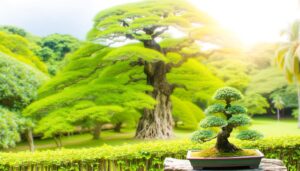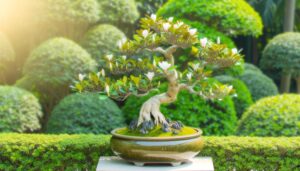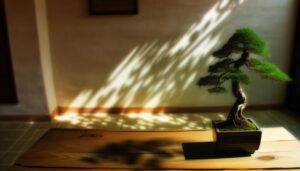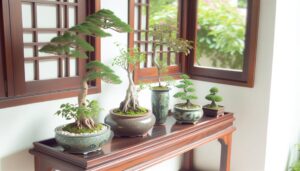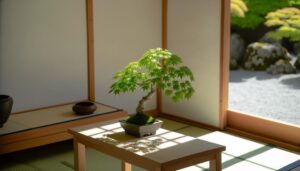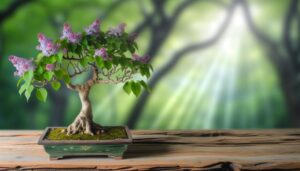7 Steps to Craft a Stunning DIY Bonsai Tree for Your Aquarium
Creating a DIY bonsai tree for an aquarium involves combining artistry with scientific precision. Select aquarium-safe driftwood such as Malaysian driftwood or manzanita.
Post-harvest preparation includes rinsing, scrubbing, boiling, and soaking in dechlorinated water. Choose hardy aquatic plants like Java moss and Anubias, securing them with fine nylon thread or aquarium-safe adhesives.
Anchor the structure with fishing line and a stable gravel foundation. Maintaining ideal water quality is vital, ensuring stable pH levels (6.5-7.5) and low nitrate levels.
Regular maintenance, including pruning and water changes, is essential to prevent algae buildup. Detailed setup instructions will provide deeper insights.
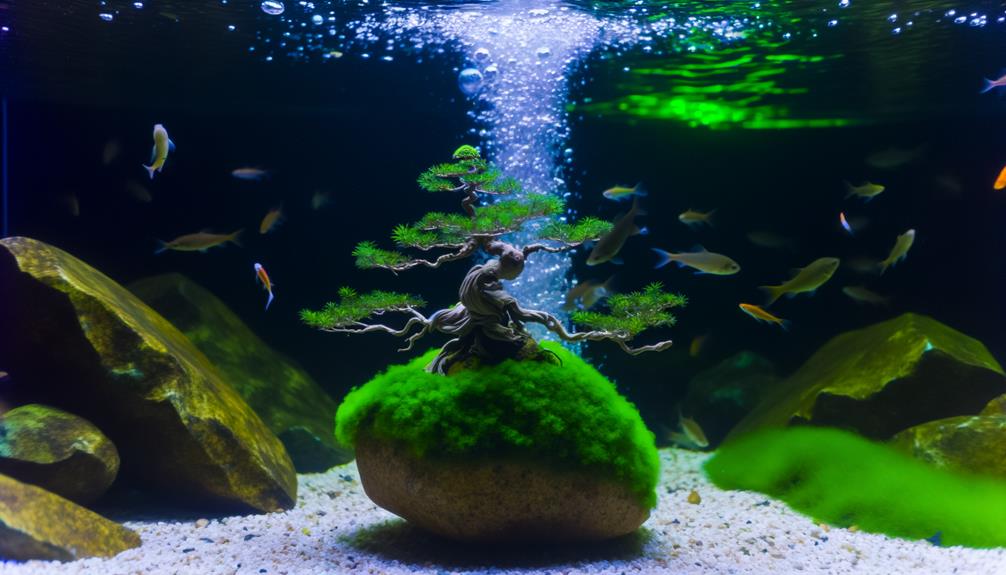
Key Takeaways
- Select aquarium-safe driftwood like Malaysian driftwood or manzanita for the bonsai tree structure.
- Boil and soak the driftwood to remove impurities and ensure buoyancy.
- Use adaptable aquatic plants such as Java Moss, Anubias, or Bucephalandra.
- Secure plants to the driftwood with fine nylon thread or aquarium-safe adhesives.
- Position and stabilize the bonsai structure in the aquarium with a gravel foundation and fishing line.
Choosing the Right Materials
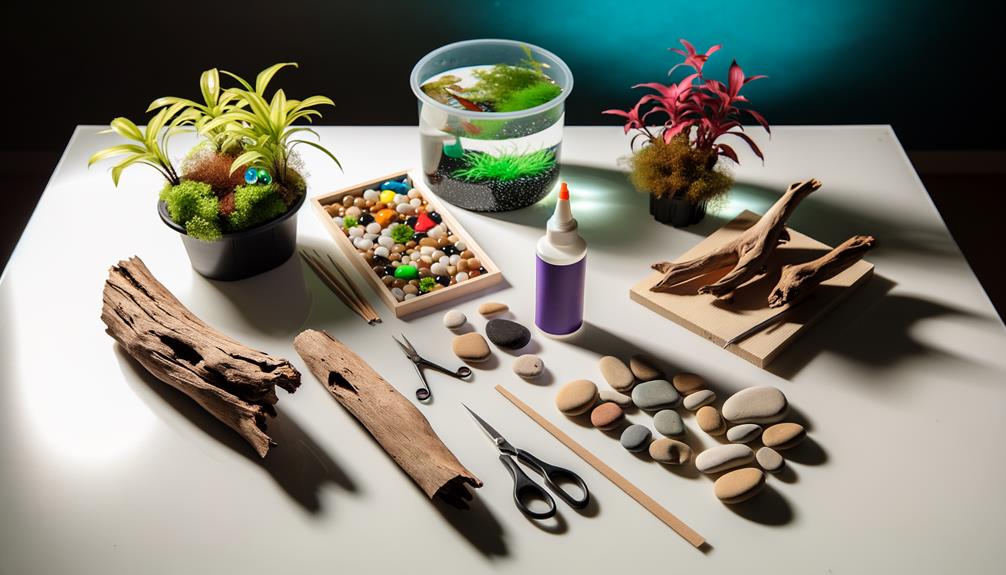
Selecting the appropriate materials for creating a DIY bonsai tree for your aquarium is crucial to secure both the visual appeal and the safety of your aquatic habitat. Start by choosing aquarium-safe driftwood, as it serves as the foundation of your bonsai tree. Opt for hardwoods like Malaysian driftwood or manzanita, which are less likely to decompose and change water chemistry.
For foliage, select aquatic plants like Java moss or Anubias, which can flourish underwater and need minimal upkeep. Additionally, utilize stainless steel wire or aquarium-safe adhesives to fasten plant components to the driftwood. Steer clear of using substances that can release harmful chemicals, such as untreated wood or non-aquarium adhesives, to maintain a healthy and steady environment for your aquatic life.
Preparing the Driftwood
To prepare the driftwood for your DIY bonsai tree, first, thoroughly clean and sanitize it to eliminate any potential contaminants. This guarantees the driftwood will not introduce harmful substances to your aquarium. Follow these steps meticulously:
- Rinse: Use a strong stream of water to rinse off any loose debris and dirt.
- Scrub: Utilize a stiff brush to scrub the surface, removing algae, moss, or other organic matter.
- Boil: Boil the driftwood in water for at least an hour to kill bacteria and parasites.
- Soak: Soak the driftwood in dechlorinated water for 1-2 weeks, changing the water daily to leach out tannins and make sure it becomes waterlogged.
Implementing these steps will safeguard the aquatic environment.
Selecting Suitable Plants
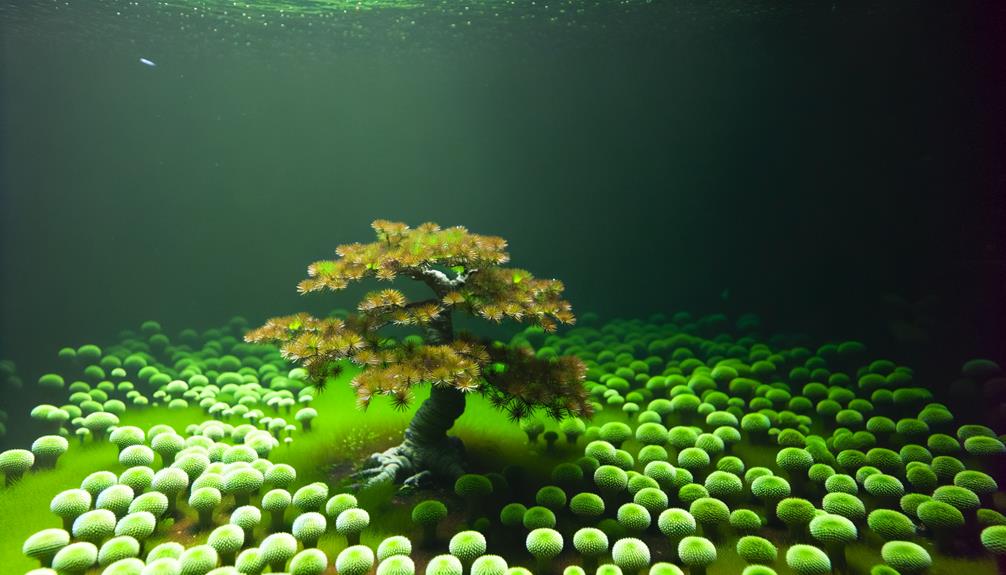
After securing your driftwood is impeccably prepared, the next step involves identifying and selecting suitable aquatic plants to create a thriving and aesthetically pleasing bonsai tree in your aquarium.
It's vital to choose plants that are both adaptable to submerged conditions and visually harmonious with the bonsai aesthetic. Popular choices include Anubias, Java Moss, and Bucephalandra due to their resilience and ease of maintenance.
Anubias varieties, like Anubias barteri, offer sturdy leaves and slow growth, making them ideal for intricate designs. Java Moss offers a dense, carpet-like appearance, closely resembling miniature foliage.
Bucephalandra, recognized for its diverse leaf shapes and colors, introduces visual appeal and texture. These selections guarantee a balanced and enduring underwater bonsai display.
Attaching Moss and Plants
Attaching moss and plants to your bonsai tree involves selecting appropriate moss species that thrive in aquatic environments and securely anchoring them to the tree structure. Techniques such as tying with thread or using aquarium-safe adhesives are critical for guaranteeing stability.
Additionally, ongoing maintenance, including trimming and monitoring for health, guarantees the long-term viability of the plants.
Choosing Suitable Moss
Choosing the appropriate moss for your aquarium bonsai tree is crucial for guaranteeing ideal growth and aesthetic balance within your underwater environment. Selecting a suitable moss involves considering both biological compatibility and visual appeal.
Key factors include:
- Growth Rate: Choose a moss that grows at a manageable pace to maintain the desired shape and size of your bonsai.
- Light Requirements: Ensure the moss matches the lighting conditions within your aquarium to promote healthy growth.
- Attachment Ease: Opt for moss species that easily adhere to surfaces, facilitating straightforward attachment to the bonsai structure.
- Maintenance Needs: Select low-maintenance moss to minimize the need for frequent pruning and upkeep.
Securing Plants Properly
Properly securing moss and plants to your aquarium bonsai tree is essential for promoting robust growth and stability within the aquatic environment. Start by using fine nylon thread or fishing line, which are both suitable for tying moss and plants to the branches and trunk of the bonsai structure.
Gently wrap the thread around the plant, making sure it's snug but not too tight, as this can damage the delicate tissues. Super glue gel is another effective option, particularly for attaching moss. Apply a small, controlled amount to the desired attachment point and press the moss firmly until it adheres.
Confirm all materials used are aquarium-safe to prevent any adverse effects on the water chemistry and overall ecosystem health.
Long-Term Plant Care
Securing the long-term health and vigor of your aquarium bonsai tree requires not only proper initial attachment techniques but also ongoing maintenance and care of the moss and plants. Consistent monitoring and minor adjustments can prevent issues and promote growth.
Here are essential steps to maintain the health of your aquatic bonsai:
- Regular Pruning: Trim the moss and plants regularly to prevent overgrowth and promote light penetration.
- Nutrient Management: Use root tabs or liquid fertilizers to provide essential nutrients and uphold water quality.
- Algae Control: Monitor and manage algae growth by adjusting lighting and introducing algae-eating species.
- Water Parameters: Sustain stable water parameters, such as pH, temperature, and hardness, to support plant health.
These actions collectively ensure the sustained energy of your underwater bonsai ecosystem.
Securing the Bonsai Structure
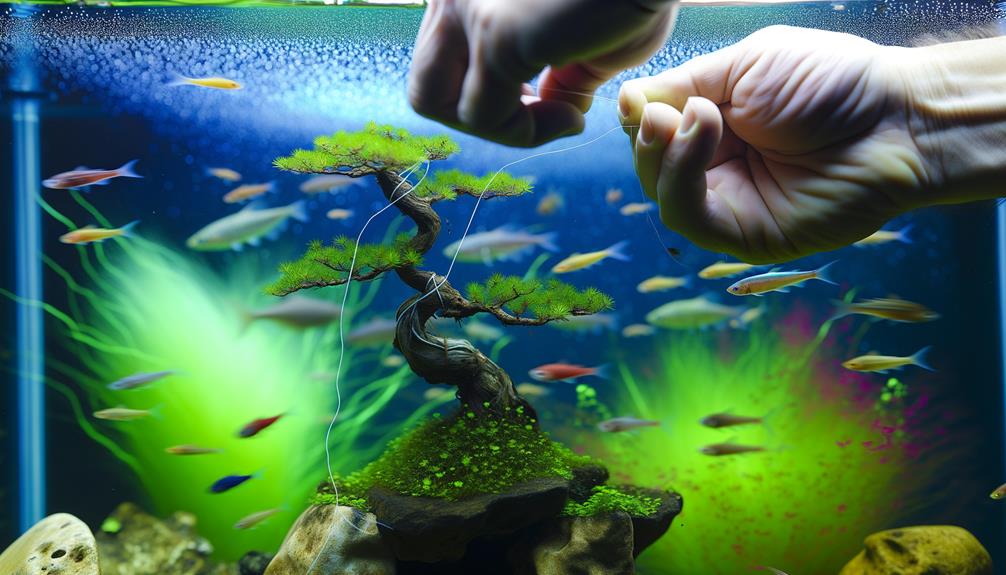
Securing the bonsai structure within your aquarium is important for maintaining stability and preventing displacement. Employ anchoring techniques such as embedding the base in gravel and using fishing line to stabilize the branches.
These methods guarantee the bonsai remains firmly in place, promoting ideal growth and aesthetic appeal.
Anchor With Gravel
To firmly anchor the bonsai tree structure within the aquarium, it is crucial to utilize a layer of gravel that provides stability and prevents displacement. This method guarantees the bonsai remains in place, contributing to the overall aesthetics and safety of the aquatic environment.
Here are key steps to effectively anchor the bonsai with gravel:
- Select Appropriate Gravel: Choose gravel with a size and weight that supports the bonsai's base without allowing movement.
- Layer the Gravel: Spread an even layer of gravel at the bottom of the aquarium to create a stable foundation.
- Position the Bonsai: Place the bonsai tree on top of the gravel, making sure it stands upright.
- Cover the Base: Add additional gravel around the base of the bonsai to further secure it.
Stabilize With Fishing Line
Once the bonsai tree is securely anchored with gravel, further stability can be achieved by strategically using fishing line to secure the structure.
Select a clear, durable fishing line to avoid visual disruption within the aquarium. Start by wrapping the fishing line around the base of the bonsai trunk, making sure it is tight but not overly restrictive.
Extend the line to anchor points on adjacent rocks or décor. Make multiple passes to distribute tension evenly, preventing the tree from tipping.
Knot the fishing line securely and trim any excess to maintain a tidy appearance. This method not only enhances structural integrity but also guarantees the bonsai remains upright, providing an aesthetically pleasing and stable environment for aquatic life.
Planting the Bonsai Tree
Choosing a suitable base is crucial for planting the bonsai tree in your aquarium, as it guarantees proper root anchorage and nutrient availability.
The following steps will guide you in selecting and preparing the base:
- Base Selection: Opt for nutrient-rich bases like aqua soil or specialized bonsai bases, making sure they provide essential minerals.
- Layering: Create a multi-layered base bed, starting with larger-grain materials at the base to enhance water flow and prevent compaction.
- Depth: Make sure the base depth is sufficient, typically 2-3 inches, to allow roots to spread and establish firmly.
- Conditioning: Rinse the base thoroughly before use to eliminate dust and contaminants, which can cloud the water and harm aquatic life.
These steps will optimize root development and overall plant health.
Setting Up in the Aquarium
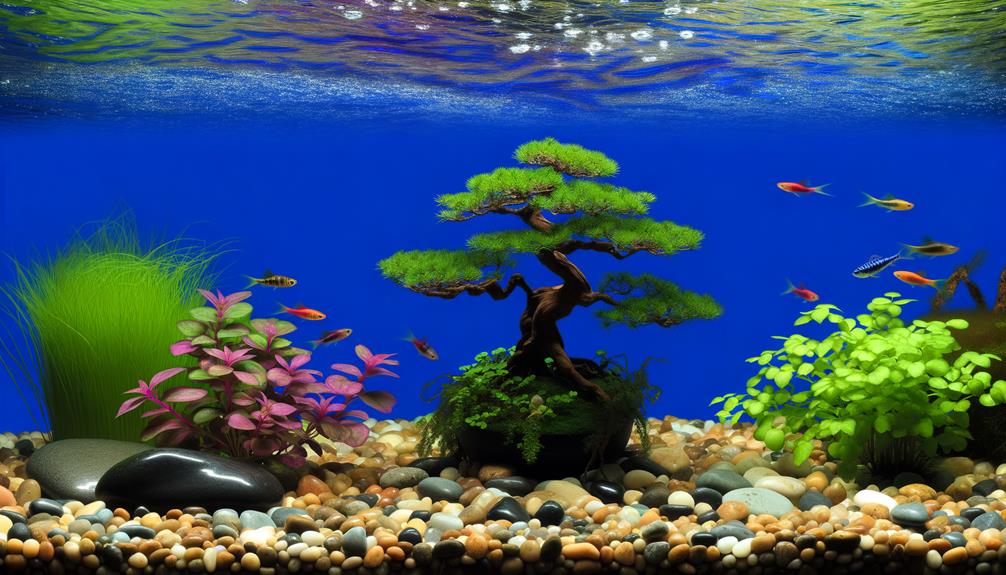
Positioning the bonsai tree correctly within the aquarium is crucial for ensuring ideal light exposure and promoting healthy growth. Start by selecting a location that receives consistent, moderate light, as excessive or insufficient illumination can hinder photosynthesis and adversely affect plant health.
Anchor the bonsai tree securely in the substrate to prevent displacement by water currents or tank inhabitants. Utilize aquarium-safe weights if necessary. Maintain adequate distance from other plants and decorations to allow unhindered growth and best water flow.
Additionally, consider the aesthetic arrangement to create a balanced and visually appealing aquascape. Monitor the tree's development and adjust its placement if growth patterns indicate a need for more light or space.
Ensuring Proper Water Quality
Maintaining ideal water quality is essential for the health and growth of an aquarium bonsai tree. Best conditions guarantee the tree receives necessary nutrients and avoids harmful substances.
To achieve this, consider the following guidelines:
- pH Levels: Maintain a stable pH between 6.5 and 7.5. Fluctuations can stress the bonsai and inhibit growth.
- Ammonia and Nitrite Levels: Ensure ammonia and nitrite levels are at 0 ppm. High levels are toxic to both the tree and aquatic life.
- Nitrate Concentration: Keep nitrate levels below 20 ppm to prevent algae overgrowth and root damage.
- Water Hardness: Monitor general hardness (GH) between 3-10 dGH to provide essential minerals for the bonsai.
Adhering to these parameters will promote a thriving aquatic bonsai environment.
Maintenance and Care
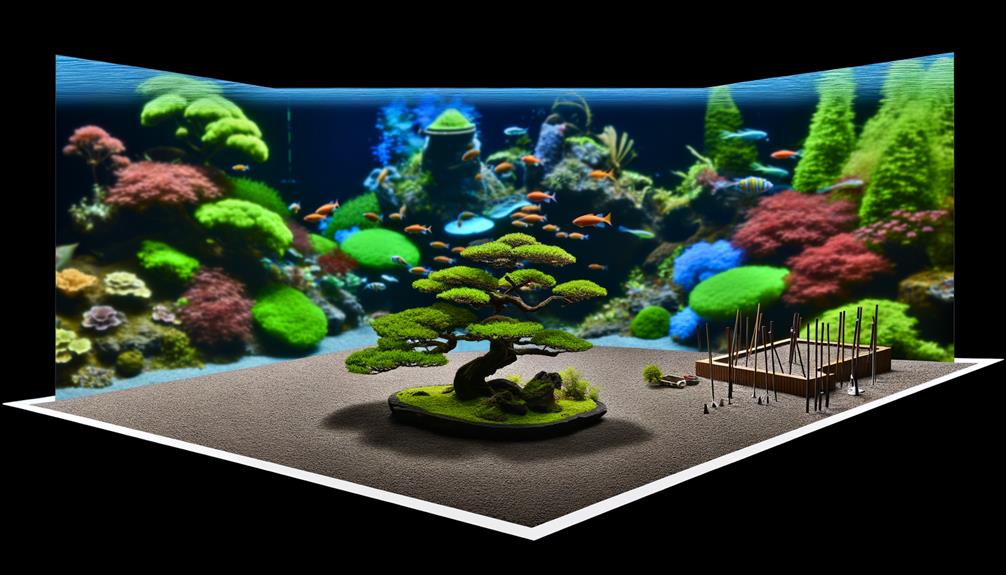
Once ideal water quality is achieved, a structured maintenance schedule is essential to guarantee the longevity and health of the aquarium bonsai tree. Regular pruning is necessary to manage growth and maintain the desired aesthetic form.
Monitor for algae buildup, as excessive algae can smother the bonsai and disrupt nutrient balance. Conduct weekly water changes, replacing 10-20% of the tank's volume, to remove waste and replenish essential minerals.
Inspect the tree and substrate for signs of decay or disease, treating promptly to prevent spread. Additionally, ensure adequate lighting and consider the use of liquid fertilizers to support plant vitality.
Consistent care will foster a thriving, visually appealing aquatic bonsai, enhancing the overall ecosystem stability.
Conclusion
The intricate process of creating a DIY bonsai tree for an aquarium involves a meticulous selection of materials.
Precise preparation of driftwood is essential, as is the careful attachment of moss and plants. Securing the structure and ensuring proper planting techniques are pivotal.
The final step involves setting up within the aquarium, which demands attention to water quality and ongoing maintenance.
What remains to be seen is the transformative impact this living art will have on the aquatic environment. This revelation promises to captivate and inspire.

